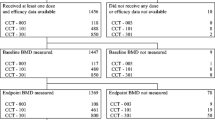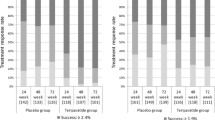Abstract:
Hormone replacement therapy (HRT) prevents postmenopausal bone loss and fractures. However, the occurrence of women with no bone response to HRT has not been widely examined. We identified the densitometric nonresponders to long-term HRT and investigated some characteristics and biochemical variables as possible predictors of densitometric nonresponse in postmenopausal women. The study population was a subsample of the Kuopio Osteoporosis Study (n= 14.220). A total of 464 early postmenopausal women were randomized into four treatment groups: (1) HRT (sequential combination of 2 mg estradiol valerate and 1 mg cyproterone acetate); (2) vitamin D3; (3) HRT + Vitamin D3 combined; and (4) placebo. In this study, the data from HRT and placebo groups were analyzed. Lumbar (L2–4) and femoral neck bone mineral density (BMD) were determined by dual-energy X-ray absorptiometry (DXA) at baseline and after 5 years of treatment. A densitometric nonresponder was defined as a woman whose 5-year BMD change was similar to the mean BMD change (+ 95% CI) of the placebo group or worse. Altogether, 74 women in the HRT group and 104 women in the placebo group complied with the treatment. According to spinal BMD analysis, 11% of the women were classified as densitometric nonresponders; the corresponding proportion for femoral BMD analysis was 26%. Both smoking (p= 0.003) and low body weight (p= 0.028) were significant risk factors for densitometric nonresponse to HRT. After 6 months of treatment the densitometric nonresponders (hip) had a significantly higher mean serum follicle stimulating hormone (FSH) level (p= 0.038) and lower increases in serum estradiol levels (p= 0.006) than the densitometric responders. The mean changes in serum FSH and alkaline phosphatase levels were significantly lower among the densitometric nonresponders (spine) than responders (p= 0.043 and 0.017, respectively). In conclusion, this prospective study shows that especially current smokers and women with low body weight are at increased risk of poor bone response to HRT. Repeated serum FSH, estradiol and alkaline phosphatase measurements during the first months of long-term HRT may be helpful in identifying the women with no bone response to HRT.
Similar content being viewed by others
Author information
Authors and Affiliations
Additional information
Received: 29 January 1999 / Accepted: 2 August 1999
Rights and permissions
About this article
Cite this article
Komulainen, M., Kröger, H., Tuppurainen, M. et al. Identification of Early Postmenopausal Women with No Bone Response to HRT: Results of a Five-Year Clinical Trial. Osteoporos Int 11, 211–218 (2000). https://doi.org/10.1007/s001980050283
Issue Date:
DOI: https://doi.org/10.1007/s001980050283




